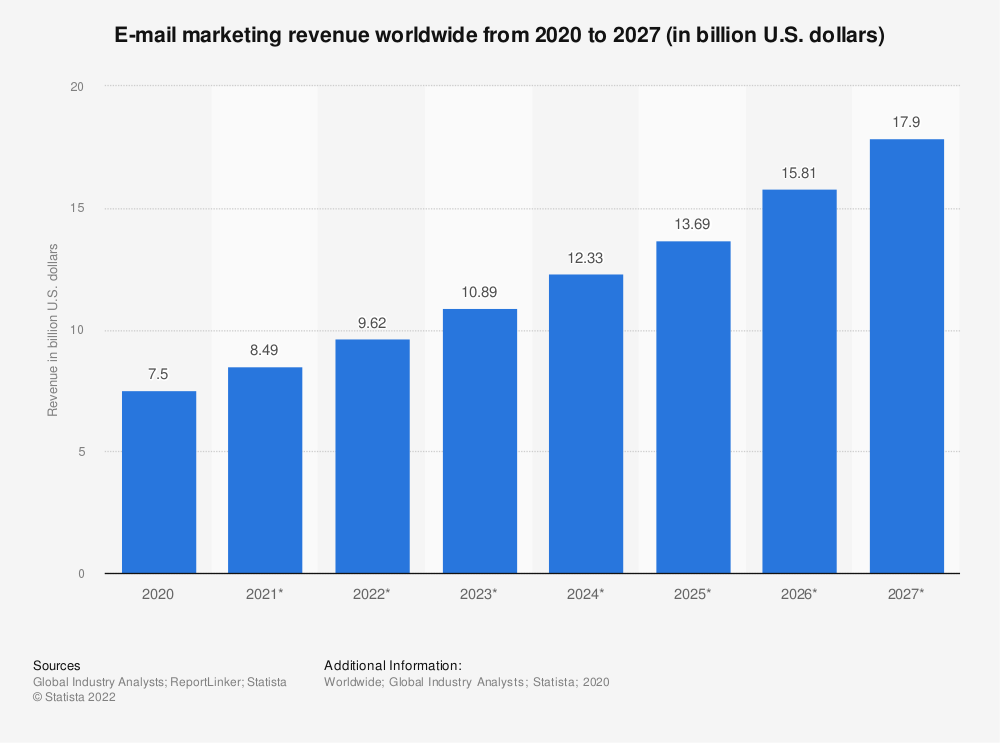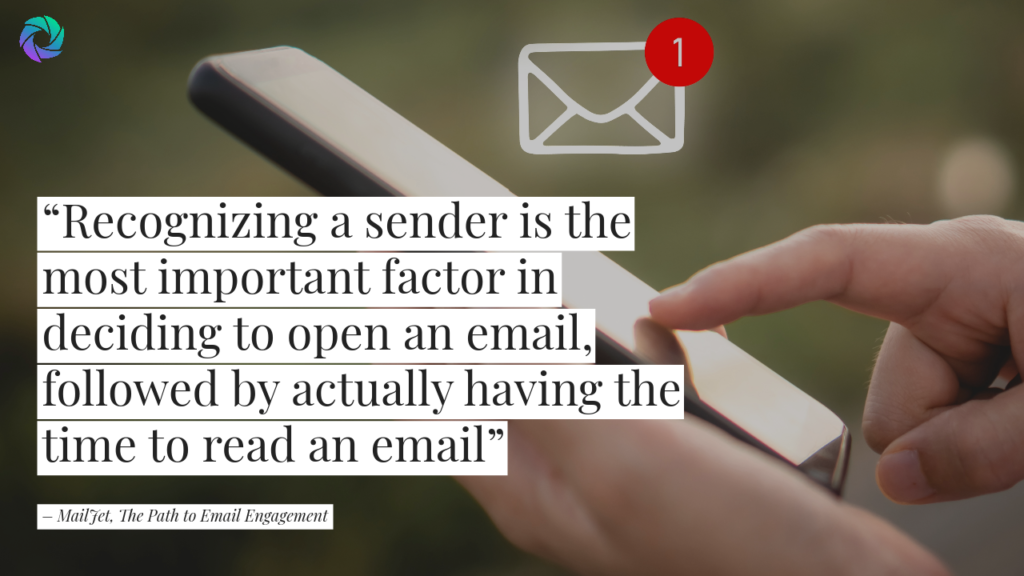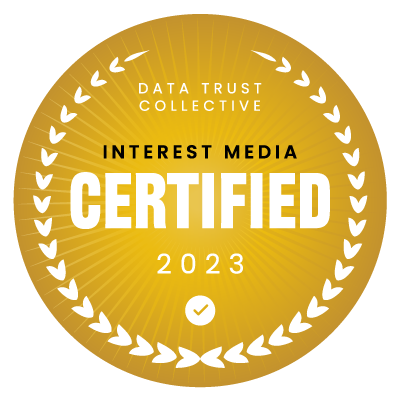
The Latest Developments in Email Marketing
- Email remains one of the best tools for performance marketing, and we bring you up to speed with the latest developments.
- AI is making it easier than ever before to automate your email marketing and add personalization – what you need to know.
- What you need to know about Google’s newest Gmail rules for bulk senders, and how to improve your email deliverability.
The Latest Developments in Email Marketing
“77% of marketers have seen an increase in email engagement over the last 12 months,” – HubSpot 2023 email marketing statistics
When it comes to reaching prospects directly, email may be one of the oldest games in town, but it remains among the best ways to laser target and engage your audience.
Email is also where the money is and will be in the foreseeable future.
“Email marketing revenue is estimated to reach almost $11 billion by the end of 2023 and $17.9 billion by 2027,” –Statista, 2021
Privacy issues will challenge email marketing
Privacy issues are becoming a significant concern, not only for email marketers but for all marketers and website operators.
We previously wrote about how “New changes in iOS and Web could sink tracking and email marketing,” and will give you a broad overview of what’s on the law books and up-and-coming.
What you need to know about Apple’s “Mail privacy protection”
In terms of email specifically, Apple’s “Mail privacy protection” (MPP) limits email tracking by masking IP addresses. This will make location tracking less accurate.
MPP preloads content before an email is opened. Because of this, MPP makes it harder for marketers to measure their open rates. MPP also prevents an email sender from seeing if and when an email gets opened.
Apple’s Hide My Email
Apple’s Hide My Email will also create problems as it allows people to hide their email addresses from both companies and other people.
New Features in Email Technology 2023
Here is a look at the new emerging trends in email marketing and technology for 2023.
Email marketing with AI
“95% of marketers who use generative AI for email creation rate it ‘effective’, with 54% rating it ‘very effective,'” –HubSpot’s State of Generative AI, 2023
Artificial intelligence (AI) is at the top of the list for the multifaceted role the technology plays in enhancing email capabilities.
Here are five of the most important things AI can do for your email marketing:
1. Data Analysis
It’s not easy sorting through vast amounts of customer data, but AI algorithms can do this with ease. AI can quickly identify engagement habits, browsing patterns, purchase history, and more. AI can then use this data to help better segment your list and personalize emails.
2. Email Segmentation
You can set, or have AI assist you with the criteria for dividing your email subscriber list into distinct groups. AI will segment your list preferences, demographics, behavior, and more. AI can greatly make the job of dividing and targeting specific audience segments much easier.
3. Personalizing Content
Everyone understands that the better you can personalize your emails, the better chance you have of getting opens and clicks. Millennials and Gen Z now expect personalized content. AI makes this cumbersome task much easier. Not only can it generate personalized email content, it can recommend subject lines, products, and more.
4. Optimizing Send Time
Using data analytics, AI can determine the optimal time to send an email to each subscriber based on their patterns of behavior. This increases the odds that your subscriber will receive an email at the time they are most likely to engage.
5. Testing
AI can automate the testing of different email elements, such as subject lines, images, calls to action, and more. AI then will analyze all this information to formulate the most effective strategies for each segment of your list.
Interactive elements in email
The need to entice subscribers to engage with email has led to the addition of several types of interactive content and emails, rather than simply static pages.
Here is a look at six of the most common interactive elements currently in use:
1. Interactive Games
Want to play again? Games are an easy way to entice users to interact by making email more fun and giving them something in return.
2. Gamification
Offering rewards or challenges is another way of turning email into a game and luring users into engaging.
3. Quizzes and Polls
Quizzes and polls, particularly those that are interactive, are yet another way to encourage recipients to participate interactively.
4. Interactive Product Carousels
Rather than having animated images that change, interactive product Carousels allow users to engage and scroll through different products, variations, and more to create an interactive shopping experience.
5. Surveys and Feedback Forms
This allows users to engage by adding their opinions through a survey or feedback form directly in the email.
6. Countdown Timers
A way of creating a sense of urgency and excitement. These typically encourage the recipient to take immediate action such as signing up for an event or making a purchase.
Google AMP for Email
AMP for email is the next evolution of email. AMP was created by Google to facilitate dynamic or interactive emails. AMP is a dynamic email format that provides a subset of AMP HTML components for use in email messages. These components allow developers to create rich engaging emails.
AMP for email was created for the Gmail web app allowing developers to include AMP components such as forms, carousels, accordions, and more inside the email, according to Mailmodo.
Google Announces Stricter Rules for Bulk Email Senders
In October 2023, Google confirmed it is tightening its rules for bulk email senders. It’s the most significant update Google has made to email in 19 years. Here are the key things that you need to know.
Google is implementing a series of new requirements for bulk email senders, which are defined as those who send more than 5,000 emails per day to Gmail addresses. Google said it will begin enforcing the new terms and conditions in February 2024.
Among the new requirements are:
Easy unsubscribe: Bulk senders must provide an easy one-click unsubscribe option.
The US Federal Trade Commission (FTC) states that marketing emails: 1) must clearly tell consumers they can opt out of getting those messages from you in the future; and 2) must include an unsubscribe link that works.
However, while most marketers provide such a link, many make you jump through hoops, sometimes several, to actually do so.
Google’s new guidelines will force marketers to comply with the one-click unsubscribe option or their emails will be blocked. Being that Gmail is the world’s largest email service, marketers can’t afford not to comply.
Strong email authentication: Bulk senders must use strong authentication methods for their emails through established protocols such as SPF, DKIM, or DMARC.
Google recognizes that auto-generated and AI-created email is going to become a bigger problem going forward. AI tools will likely have the capability to trick spam filters. As a result, Google is tightening its controls by forcing senders to prove they are who they say they are by authenticating their identity, Inc. reports.
A clear spam rate threshold: Gmail will enforce bulk senders to only send mail that is wanted by subscribers. Google will enforce a clear spam rate threshold that bulk senders must stay below.
Senders who bombard Gmail recipients with unwanted messages will find themselves blocked. The company says it already blocks more than 15 billion emails per day. Bulk senders cannot afford to be blocked from Gmail given it has more than a billion users.
How to Stay Compliant
The following four practices will help bulk senders adhere to Google’s new rules. These are good practices even if your email list is below 5,000 recipients.
- Use a reputable email service provider: Use an ESP that provides features to help facilitate your ability to keep your email delivery compliant.
- Regularly review and sanitize your email list: Use an email validation service and remove email addresses that aren’t in use and/or outdated.
- Segment your email list: Better target your subscribers by dividing your list into smaller, more specific segments rather than take a “one-size-fits-all” approach to your list. Tailor the content specifically for each segment.
- Personalize emails: As much as possible, personalize your emails to each segment, as well as to individual users. AI and other services can help with email personalization.
3 Easy Steps to Improve Your Email Deliverability
“The most effective strategies for email marketing campaigns are subscriber segmentation (78%), message personalization (72%), and email automation campaigns (71%),” – HubSpot Blog Research
Email deliverability refers to the number of emails that successfully reach an inbox and don’t get flagged as spam.
Don’t confuse email deliverability with an email delivery rate. The latter refers to the total number of emails that are delivered to an email address, whether they land in the inbox or the spam folder.
Here are 3 things you can do to have a positive effect on the deliverability of your email.
1. Verify the validity of your email list regularly.
An easy way to do this is using an email verification platform. Services such as ZeroBounce can validate around 100,000 contacts in about 45 minutes. This is a quick way of finding how many email addresses are still in use and which ones are outdated.
Another way of keeping your list sanitized is to connect an email verification API to any lead collection form you use. This API will work silently in the background rejecting any poor-quality addresses. Verification APIs only allow real, valid email addresses to be added to your list.
2. Send content subscribers to expect when it’s expected
Many ISPs monitor your email engagement. This signals to them that your content is relevant. They look at the number of opens and clicks. If your emails aren’t being opened or clicked, your ISP may start to flag them as spam.
One way to prevent this from happening is to do two things:
A. Send your audience the content they expect to receive. If you promised a weekly newsletter on a given topic – do that. Don’t send your newsletter plus two more sales emails, or emails for an affiliate product unless that’s what was promised.
B. Send your content when it is expected. For example, if you promise a weekly or monthly newsletter – deliver on time and regularly. Be consistent in sending your newsletter at the frequency people signed up for. Don’t send more emails than people expect to receive.
C. Look for these spam triggers and test. Certain things can potentially trigger your emails to be flagged as spam. Let’s take a look at three of the most common red flags for spam and the steps you can take to avoid triggering them.
3. Know the most common spam triggers:
- Emails with more images than text. You need a balance in the ratio of images versus text. Make sure to include enough text.
- Use of link shortening URLs. So-called “pretty” links may look cleaner on the page, but they also trigger spam filters. Use the full and actual URL when possible.
- Inconsistent sending patterns. As previously mentioned, sending email on an irregular basis can draw a spam flag. This is especially true if it’s been too long since the last time you emailed your list.
One way to get around this is to warm up your IP before doing a mass send. Break up your list into smaller groups so that you are sending low volumes of emails on your dedicated IP. Do this over some time, gradually increasing your email volume.
“Warming up” an IP address allows ISPs to identify, recognize, and evaluate your sending practices. Once you pass their test, you are much more likely to get a green light for your entire email list.
Publishers: Interest Media Offers a Complete Omni-Channel Solution
Interest Media helps publishers drive engagement and value in powerful and unique ways.
Interest Media offers a complete omni-Channel solution across email, display, push, SMS, and more. We currently deliver thousands of exclusive offers, derived from the internet’s most valuable consumer verticals, to publishers seeking increased earnings.
Follow this link to start maximizing earnings for your traffic and find out how Interest Media uses precise targeting the match your audience with the most relevant offers from today’s biggest brands. Fill out the form and one of our monetization experts will show you how it works.














